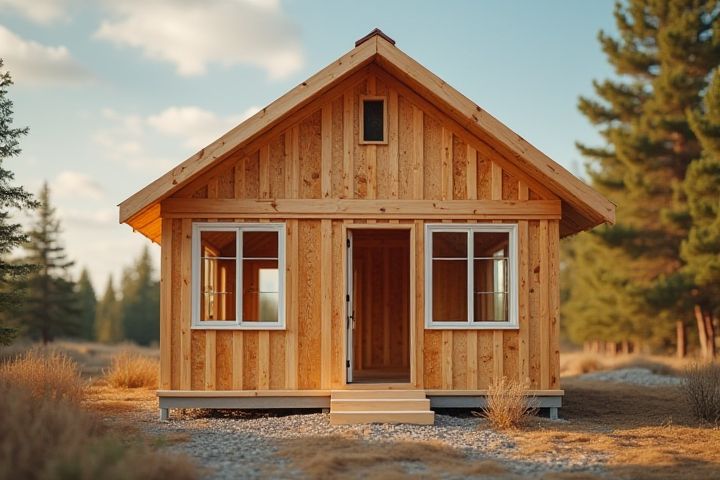
Building a house on a budget requires careful planning and smart financial management. Begin by creating a detailed budget that estimates costs for land, materials, labor, and permits, ensuring you account for all potential expenses. Opt for cost-effective materials, such as alternative framing options like metal or structural insulated panels, which can reduce labor costs and improve energy efficiency. Engage with reliable contractors who offer fair pricing and transparent communication to avoid unexpected charges during construction. Consider a flexible design that allows for future improvements, enabling you to manage expenses whilst still creating a functional living space.
How To Build A House On A Budget
Plan and design efficiently
Begin with a detailed plan that outlines your budget, aiming for a clear breakdown of costs associated with materials, labor, and permits. Opt for a simple design, which not only reduces material expenses but also minimizes labor costs; consider a one-story layout for better accessibility and lower construction complexity. Prioritize energy-efficient features, such as proper insulation and energy-efficient windows, which will lead to long-term savings on utility bills. Engage with local suppliers for discounts on bulk purchases and explore pre-fabricated components that can further streamline the building process within your budget.
Choose cost-effective materials
To build a house on a budget, selecting cost-effective materials is crucial. Consider using structural insulated panels (SIPs), which can reduce labor costs and improve energy efficiency by maintaining better insulation with lower energy consumption. Reclaimed wood or recycled materials for flooring and finishes can provide unique aesthetics while decreasing expenses by up to 30%. Additionally, opting for vinyl siding over wood or brick can save you approximately 20% on exterior costs while still offering durability and low maintenance.
Opt for energy-efficient solutions
Consider selecting energy-efficient appliances that can significantly reduce utility bills over time; for example, ENERGY STAR-rated refrigerators and washing machines can save you about 10-50% on energy costs. Insulating your home with spray foam or fiberglass insulation, which typically costs between $0.80 to $2.00 per square foot, can help maintain temperature control, reducing heating and cooling expenses by up to 20%. Installing energy-efficient windows, with triple or double glazing, can improve home efficiency and can cost around $450-$600 per window, leading to savings on energy bills. Lastly, implementing renewable energy sources, such as solar panels, which range from $15,000 to $25,000 for an average-sized house, can further decrease your long-term costs while boosting property value.
Hire a reputable general contractor
Hiring a reputable general contractor can significantly impact your budget when building a house. Look for professionals who have at least 5-10 years of experience and a strong portfolio of completed projects. Verify their credentials, including licenses, insurance, and reviews from previous clients, to ensure quality workmanship. A skilled general contractor can provide cost estimates, negotiate with suppliers, and help you stay on budget by managing subcontractors efficiently.
Consider prefabricated options
Consider prefabricated options to significantly reduce construction costs and time when building your house. Prefabricated homes are manufactured off-site, allowing for streamlined assembly and minimizing labor expenses. These houses come in various designs and styles, offering flexibility while also being energy-efficient due to modern materials and construction techniques. By choosing a prefabricated option, you can invest your budget wisely into high-quality finishes and sustainable features that enhance the value of your new home.
Prioritize essential features
To build a house on a budget, prioritize essential features like energy efficiency and durable materials. Focus on a smaller footprint, as square footage directly influences construction and long-term maintenance costs. Invest in high-quality insulation to save on energy bills, targeting R-value ratings of 20 or higher for walls and 30 for attics. Consider a streamlined design with open floor plans, which can reduce both labor and material expenses while creating a spacious feel.
Reuse and recycle materials
Building a house on a budget can be effectively accomplished by prioritizing the reuse and recycling of materials. Salvaged wood from old barns, pallets, or deconstructed buildings can serve as structural elements or decorative features, reducing costs while adding character. Recycled bricks or stones can be used for exterior walls or walkways, and reclaimed fixtures, such as doors and windows, can enhance both functionality and aesthetics. By sourcing materials from local demolition sites or secondhand stores, you not only minimize expenses but also contribute to environmental sustainability.
Obtain necessary permits
To build a house on a budget, obtaining the necessary permits is a crucial initial step, as failure to comply can lead to costly fines. Research your local zoning laws and building codes to understand the types of permits required, which may include a building permit, electrical permit, and plumbing permit. Allocate between $500 and $2,500 for these permits, depending on the complexity of your project and your location. Ensuring all paperwork is in order before construction begins not only saves money but also helps avoid delays in your project timeline.
Perform some tasks yourself
Performing tasks yourself can significantly reduce the overall cost of building a house, allowing you to allocate funds more efficiently. By taking on projects such as painting, landscaping, or even framing, you can save between 20% to 40% on labor costs. Utilizing online resources and tutorials will enhance your skills, enabling you to complete these tasks more effectively. Completing just a few key tasks can empower you to invest your savings back into other essential areas of your home construction.
Keep a detailed budget list
Keeping a detailed budget list is essential when building a house on a budget. Start with a comprehensive breakdown of costs, including land acquisition, permits, materials, and labor, ensuring to allocate around 15-20% for unexpected expenses. Use digital tools or spreadsheet software to track your expenditures in real-time, allowing you to adjust your spending as needed. Regularly revisiting this budget list will help you identify areas for savings, ensuring that you stay within your financial limits while achieving your dream home.
